Roland Schwab’s Tristan und Isolde, Bayreuth 2023
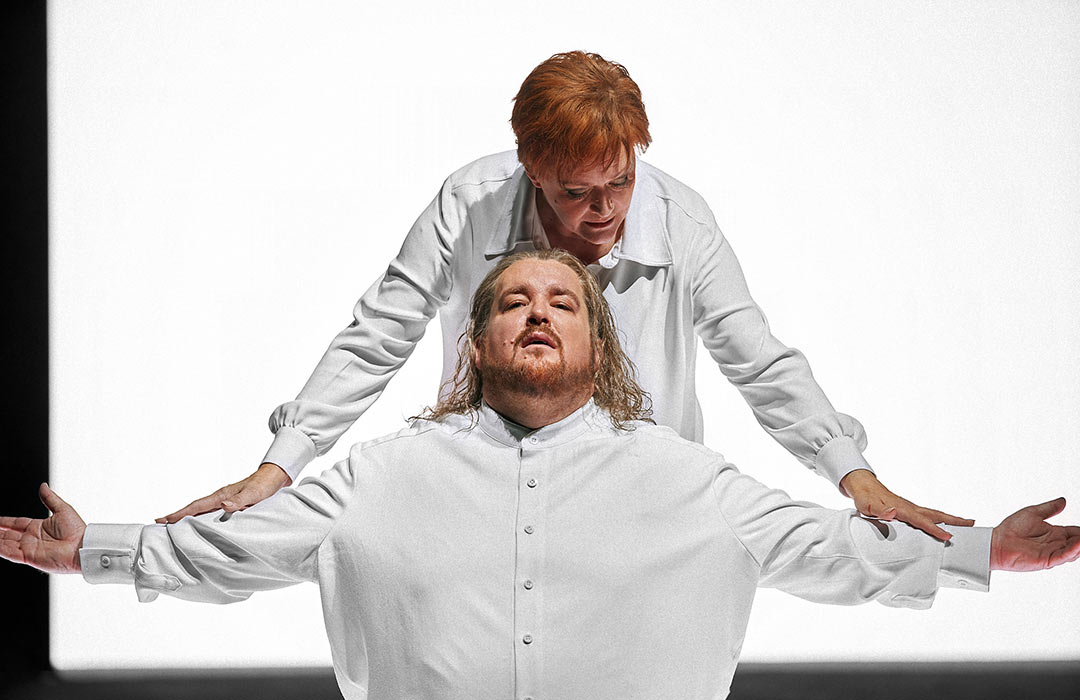
Catherine Foster and Clay Hilley in Roland Schwab's production of Tristan und Isolde. Photo Enrico Nawrath/Bayreuther Festspiele
Just as horse racing aficionados remember the 1993 Grand National as “the race that never was”, Bayreuth whisperers may come to remember Roland Schwab’s Tristan und Isolde as “the production that never should have been”; not on account of its quality, but due to how a new Tristan was never intended to premiere in 2022 at all. Added to the programme last year at the eleventh hour to act as a Covid-safe emergency option, it returned this year for a final, limited run of two performances, meaning its presence at the festival has been a uniquely fleeting one.
Did the short gestation period show? I don’t think so. There was a simplicity to the production for sure – all the action took place on the same set – but then, this is not an opera that easily lends itself to “complicated” stagings in general. Can one readily imagine a Frank Castorf Tristan, for instance? It’s difficult to (although I’d certainly like to see him try). Rather, simplicity was a directorially choice; and while frankly I don’t think this was a production that revealed much at all in the way of new insights into the work – a large part of it was basically rather “traditional” at heart, albeit with some video effects – at the same time, one can say it succeeded on its own terms, delivering its message clearly, and at times with some style.
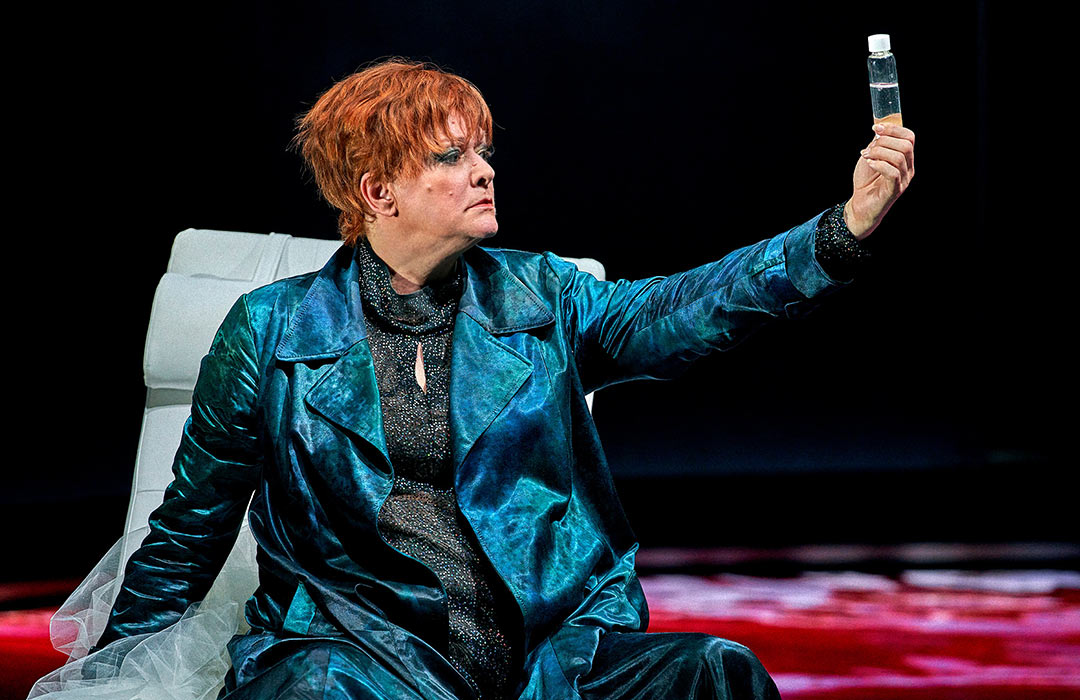
Catherine Foster (Isolde) in Roland Schwab's production of Tristan und Isolde. Photo Enrico Nawrath/Bayreuther Festspiele
If Katharina Wagner’s superb 2015 production focused on making us question how healthy it was to view love in the way the title characters do, essentially comparing them with two self-harming teenagers, Schwab practically invites us to do the opposite, to get swept away like not-so-young Werthers in thoughts about the idea of a utopian eternal love, as well as a real-life archetype of it. Indeed, the latter was introduced immediately in the Vorspiel, when a young girl and boy were seen sitting arm in arm, seeming to make us witnesses to the first realisation of affection between young sweethearts. The pair departed before the start of the first act proper, which took place in a non-specific location that could pass for a ship, or not. Either way, the only notable features of the set were two discs: one revealing a blue sky above, the other a pool of equally blue water on the floor. As the evening progressed, it would be these two discs that would do the lion’s share of the work in terms of depicting the changing mental states of the characters, and for the most part they would do so effectively, if a little repetitively.
Isolde first appeared dressed in black and wearing sunglasses, in what was perhaps a foreshadowing of the night/day dichotomy, and an indication that some longing for the night and all that goes with it was within her before any potion had been drunk. Tristan, meanwhile, stood above, in the shadows but looking outward to the bright daytime sky. As the story of Morold and Tantris was told, the blue water in the pool below gradually turned red, before becoming grey as the sky also became darker and angrier in the moments leading up to the drinking of the potion. At this point, the grey water became a whirlpool, and any remaining elements of realism in what it was depicting were left firmly behind when the lovers walked on top of it, and tried in vain to cling to one another against its currents as the curtain came down on the act.
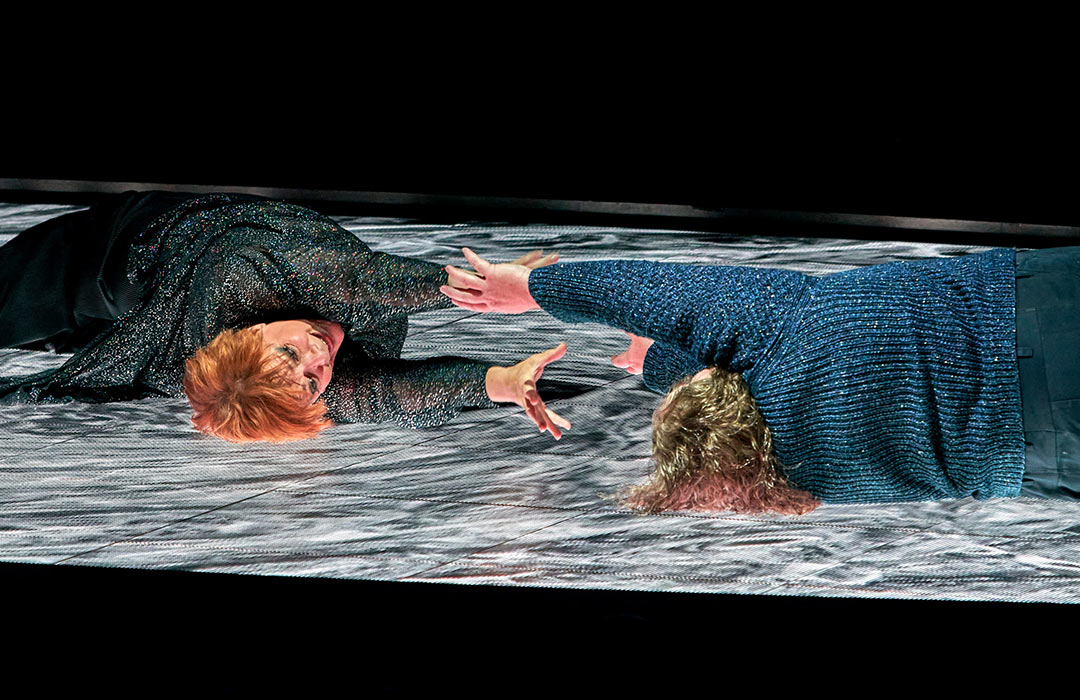
Catherine Foster and Clay Hilley in Roland Schwab's production of Tristan und Isolde. Photo Enrico Nawrath/Bayreuther Festspiele
Act II opened with both the pool and the sky full of stars, and Isolde (and later Tristan) now dressed in white. A starry sky, of course, is both literally the night, and also an example of something beautiful and seemingly endless, and it acted as that here with the lovers surrounded by the pool during the duet. Then, at “O sink hernieder…”, the other couple seen in the Vorspiel appeared above, but now as young adults stargazing. Rightly or wrongly, this seemed to be Schwab holding the development of this relationship up to us as a paradigm of utopian love. As the duet moved towards its (interrupted) climax, the stars in the pool then became denser and more chaotic, before the room lit up at “Rette dich, Tristan!”. Whether the use of searchlights was a deliberate nod to the previous Bayreuth production I am not sure, but the final scene of the act featured Melot using one as a quasi instrument of torture on both Tristan and Isolde. Stylised shards of light descended slowly from the ceiling throughout, and eventually seemed to electrocute Tristan.
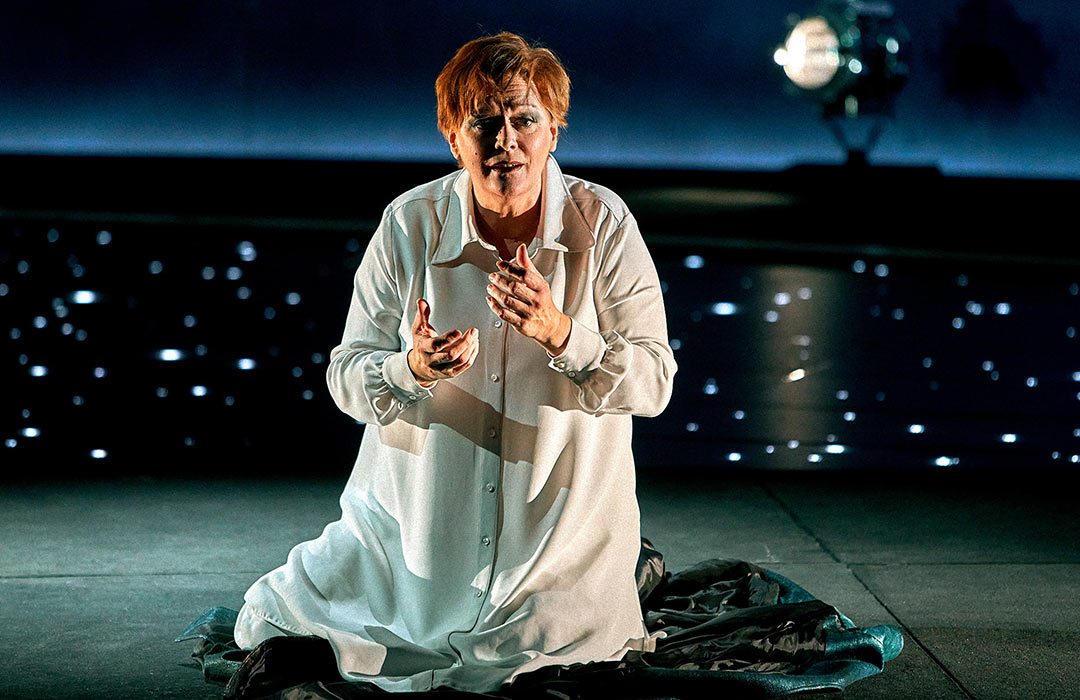
Catherine Foster (Isolde) in Roland Schwab's production of Tristan und Isolde. Photo Enrico Nawrath/Bayreuther Festspiele
The same basic set, including the pool of stars, remained for the final act, except some vines or branches now hung down from above. Throughout the action, Tristan remained in the realm of night within the pool, the stars often waxing or waning in number and brightness depending on his level of lucidity, while Kurwenal circled around from a distance, quickly escaping back to safe ground when Tristan briefly dragged him into the pool with him. An eye then appeared within it when Tristan sang “siehst du sie noch nicht?”, the black pupil contracting and expanding, and the iris spinning like the Milky Way as Isolde’s ship grew nearer. As the Liebestod began, Isolde wrapped herself around some of the tree branches falling from above, while the ”real-world” couple returned one final time. Now, they were old, and circled around the stage separately, before meeting in the middle again and holding hands on “…in des Welt-Athems” – a nice bit of Personenregie in sympathy with the music, if nothing else. As the curtain came down, Isolde, still very much alive, pointed at them.
Regarding this ending, Schwab’s intentions need little further explanation than what is in the programme notes. In them, he gives a brief synopsis of the story of Baucis and Philemon from Greek mythology – a couple who had lived and grown old together, whose reward from the gods for good deeds was to die simultaneously, so that neither would ever have to be without the other. When the time came, they bade each other a final farewell, and were transformed into a pair of intertwining trees – their love outlasting their deaths.
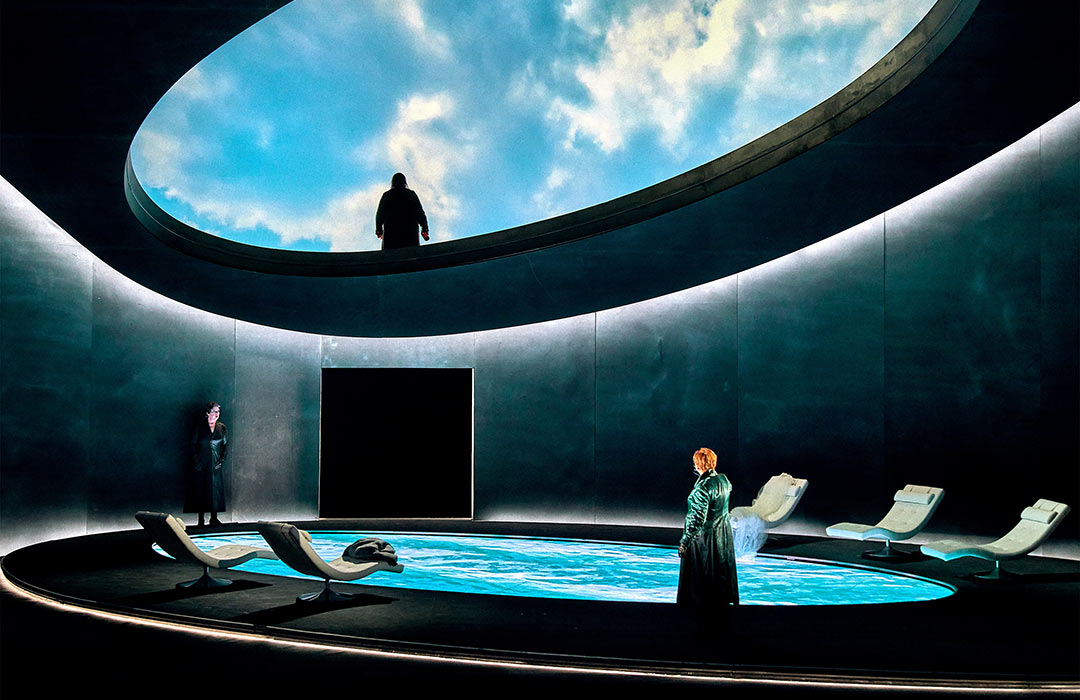
Roland Schwab's production of Tristan und Isolde. Photo Enrico Nawrath/Bayreuther Festspiele
Does this work? To some extent, but not entirely, I think. The idea of a love that outlasts death, and flourishes after it, is perfectly in keeping with the work, but the presentation of a couple who have seemingly been able to express their love for each other openly and happily from childhood through to old age runs against the grain of the idea of the impossibility of Tristan and Isolde ever being as one in the phenomenal world. Of course, its fine if a director wants to subvert a libretto deliberately to make a point, and such a reference could reasonably be used as an attempt to portray an unachievable stereotype of love, one that neither the characters in the opera, nor we, should ever expect to realise. However, given Schwab’s comments about utopias and “wanting to achieve a sense of escapism”, it seemed to me more a matter of him saying “the idea of love is eternal, don’t overthink it”. One might also take issue with the use of what is essentially an old-fashioned “Honey, I’m home!” portrayal of what love should ideally look like as the sole example held up to us. After all, love can be many things: short-lived, or long-lasting; found early, or discovered late; straight, or gay; smooth, or tempestuous; uninterrupted, or periodic; requited, or unrequited; immediately acted upon, or slow-burning; sexual, or platonic, and still be just as deep and true. Having said all that, any of my close friends would tell you that, instinctively, I am a sucker for these sort of romanticised notions of things, and I’d be lying if I said a little part of me didn’t give in to Schwab towards the end and feel moved by the idea of an old couple who have spent their entire lives with one another.
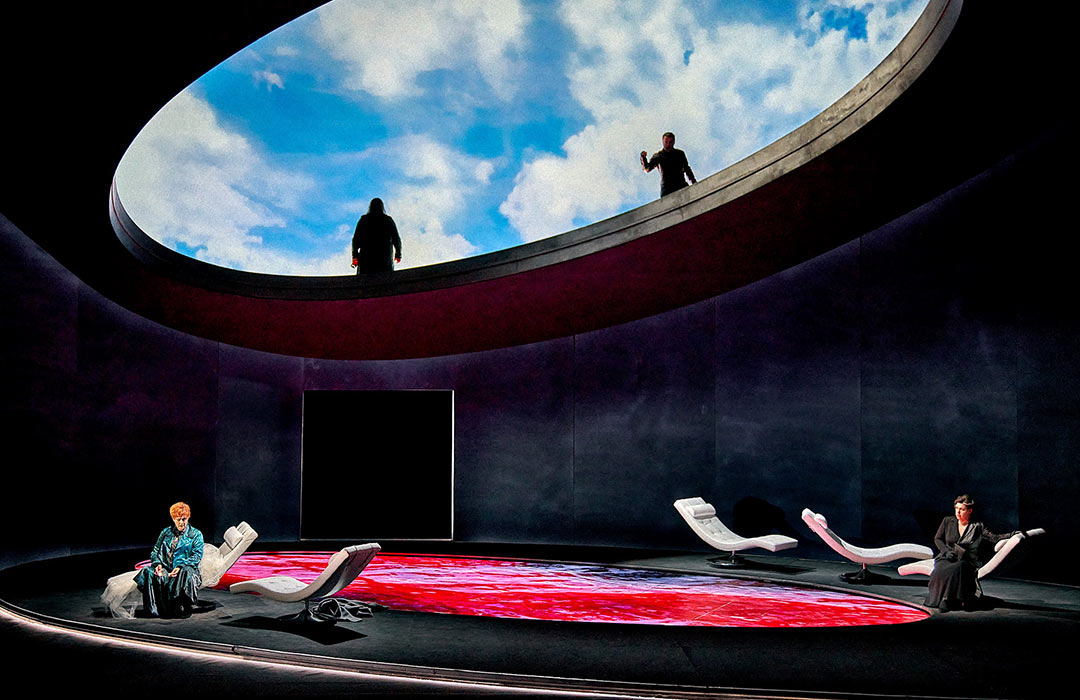
Roland Schwab's production of Tristan und Isolde. Photo Enrico Nawrath/Bayreuther Festspiele
Musically, the conducting of Markus Poschner surprised in several ways. On the positive side, I thought the love duet was rather expertly handled – taken at a steadier pace than one often hears, yet never without a sense of forward progress. The tempi, coupled with a genuine, ethereal pianissimo at times, produced a hushed, dare I say Parsifal-like timelessness and beauty to some of the middle act, that nevertheless rose and fell organically to and from its peaks. On the other hand, balance between pit and stage, not usually a problem in the Festspielhaus, was an issue in the outer acts. I don’t mind a balance slightly in favour of the orchestra, but nearly all the principals were drowned out at some point, not in the loudest moments, but in mezzo forte/forte passages.
As Isolde, Catherine Foster was the dramatic star of the evening, allying a committed, intense acting performance with singing that was at times powerful and indignant, at others, tender and sweet. Clay Hilley sang tirelessly opposite her as Tristan, maintaining tone and intonation fully through the almost impossible demands of Act III. If his acting did not quite have the nuance of Foster, he nevertheless threw all the energy he had into the role.
Whether it would be realistic for her register or not I don’t know, but Christa Mayer as Brangäne gave the impression that she could make a fine Isolde on another day, her fullness of tone and effortless projection standing out. I heard Markus Eiche sing in the first Bayreuth production I ever attended back in 2014 – I liked his voice then, and I like it now. Additionally, he was typically attentive to the text and at ease on stage as Kurwenal. This was the sixth season since 2015 that Georg Zeppenfeld was singing King Marke on the Hill, and based on the ever-present clarity with words and attention to detail in this performance, I doubt anyone would be upset if he continued in the role for another six seasons. Olafur Sigurdarson also made an impression as a gruffer, burlier Melot than one usually sees, while all the smaller roles were well taken.
If I had to sum this production up in one word then, I think I might choose “indulgent”. It’s aim seemed to be for us to lose ourselves, not in wistful thoughts of love being unattainable, but in feelings of how beautiful it is when love conquers all; and it provided a simple, easy-on-the-eye setting in which to do that, with a bit of a schmalzy ending. It didn’t make me sit up and think all that much, and I’d take Katharina’s darker, more cerebral production over it every day of the week, but there was a craftsmanship to its realisation, and if Schwab’s goal were indeed to provide a sense of escapism, then one has to say he delivered it.
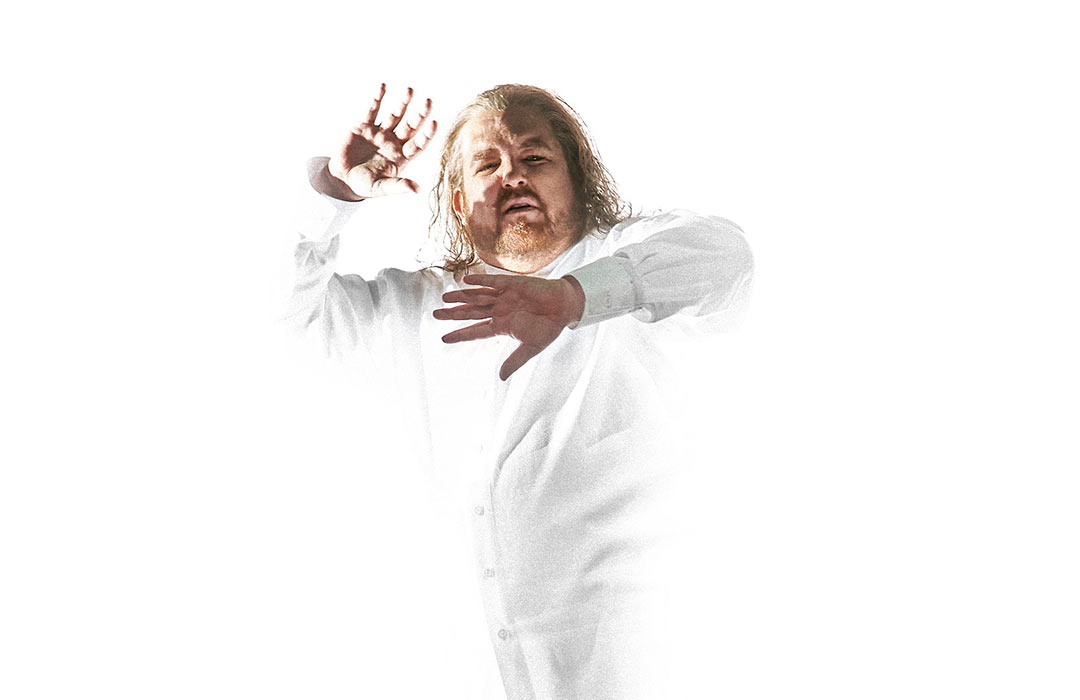
Sam Goodyear
Sam Goodyear is an opera fan and Wagner enthusiast, originally from Portsmouth but now living in Germany. He read history at Peterhouse, Cambridge, and has at various times worked as a bookie, translator, trader, journalist, and TV researcher. He currently works in socially responsible investment. While very much an amateur, his interest in music has in the past led to him singing on BBC radio, and playing the trumpet in front of the queen. He attends as much Wagner both at home and abroad as time and money will permit, and he has written on Wagner for Classical Music Magazine.
Tristan und Isolde Cast 2023
Conductor: Markus Poschner
Director: Roland Schwab
Stage design: Piero Vinciguerra
Costumes: Gabriele Rupprecht
Dramaturgy: Christian Schröder
Light: Nicol Hungsberg
Chorus master: Eberhard Friedrich
Video: Luis August Krawen
Tristan: Clay Hilley
Marke: Georg Zeppenfeld
Isolde: Catherine Foster
Kurwenal: Markus Eiche
Melot: Olafur Sigurdarson
Brangäne: Christa Mayer
Ein Hirt: Jorge Rodríguez-Norton
Ein Steuermann: Raimund Nolte
Junger Seemann: Siyabonga Maqungo
Bayreuth 2015
- Erling E. Guldbrandsen: Katharina Wagner's Tristan an Artistic Triumph
- Erling E. Guldbrandsen: One-dimensional and unmoving Dutchman
- Sam Goodyear: A Darkly Psychological, Un-romantic, but Striking Reading of Tristan und Isolde
Reviews by Sam Goodyear
Deutsche Oper Berlin 2024: Stefan Herheim's production of Der Ring des Nibelungen
Bayreuth Festival 2022: Valentin Schwarz' production of Der Ring des Nibelungen
Bayreuth Festival 2023: Roland Schwab's production of Tristan und Isolde
Bayreuth Festival 2023: Jay Scheib's production of Parsifal
Staatsoper Berlin 2022: Dmitri Tcherniakov's production of Der Ring des Nibelungen: Das Rheingold
Staatsoper Berlin 2022: Dmitri Tcherniakov's production of Der Ring des Nibelungen: Die Walküre
Staatsoper Berlin 2022: Dmitri Tcherniakov's production of Der Ring des Nibelungen: Siegfried
Staatsoper Berlin 2022: Dmitri Tcherniakov's production of Der Ring des Nibelungen: Götterdämmerung
Bayreuth Festival 2017: Barrie Kosky's production of Die Meistersinger von Nürnberg
Bayreuth Festival 2015: Katharina Wagner's production of Tristan und Isolde



